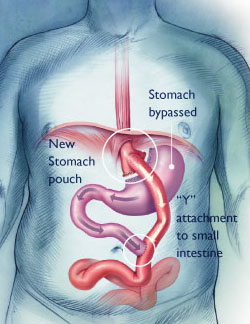- Home
- Meet The Team
- For Patients
- For Doctors & Nurses
- Blog
- Patient Journeys
- Patient Weight Loss Journeys
- Kelly: A New Lease On Life
- Ali: Motivated By Family
- Ramona: Support To Be Healthy
- LuckyMe: From Yoyos To Weights
- Jasmine: A New Zest For Life
- Rosa: Life Is Literally Incredible
- Mae:No Regrets
- Ella Diva: Confidence Returns
- Jamelle: Changing Family History
- DACA: A Second Chance At Life
- Contact
- Weight Loss Surgery
- Hernia and General Surgery
Gastric Bypass
Laparoscopic Gastric Bypass

The laparoscopic gastric bypass was the commonest weight loss procedure performed worldwide for many years. It was first performed in the United States back in 1967. It produces excellent weight loss of between 65% to 75% of excess weight and obviously has a long track record. The operation involves creating a small pouch at the end of the oesophagus from the upper part of the stomach. The rest of the stomach is disconnected and left inside. A loop of small bowel, commonly 150cm in length, is then brought up and attached to the new stomach pouch. The proximal small bowel containing the digestive juices is then joined to this loop of small bowel at about 100cm. This means that when you eat your food goes through the small pouch and into the new loop of small bowel but does not meet the digestive juices for 150cm.
For superobese patients and some revisional cases, a fixed ring can be added, which can reduce the risk of weight regain.
Gastric Bypass Procedure
The procedure is performed with keyhole (laparoscopic) surgery. Patients usually stay two days post-operatively before going home. Typically, you have very little, if any, appetite for four to five months and it is during this time that you have the most rapid weight loss. It is important that you establish your healthy eating patterns in those first five months before your appetite returns.
Effective for Type 2 Diabetes Sufferers
The laparoscopic gastric bypass is particularly beneficial to Type 2 or non-insulin dependent diabetics. There are increasing numbers of studies demonstrating that diabetics who have this operation performed have a very rapid improvement in their diabetic control well before they gain the benefits of weight loss. This is felt to be due to the diversion of the food stream away from the first part of the small bowel, the duodenum and jejunum. Studies, particularly from the United States, have demonstrated up to 87% resolution of Type 2 diabetes following laparoscopic gastric bypass procedures.
Revisional Gastric bypass
The laparoscopic gastric bypass is also a good operation for patients who have had gastric band surgery and who are not happy with their band or are not doing well with their band. It is possible to convert a gastric band patient to a laparoscopic gastric bypass as a one-stage procedure. In this case, the addition of a fixed ring to the bypass is usually recommended.
The Gastric bypass is also the best anti-reflux operation and is recommended as revisional surgery for sleeve patients suffering from significant reflux.
Surgical Outcomes
Following gastric bypass, you may experience an intolerance to certain types of food, usually fatty greasy foods, dairy products, and/or sweets (lollies) which may cause unpleasant symptoms similar to sea sickness such as sweating, nausea, shaking, abdominal pain and/or diarrhoea which lasts from a few minutes to an hour. This is known as “dumping” syndrome. Some patients regard this as a useful side effect at it reinforces their inability to consume high calorie foods. I would prefer that you concentrate on developing a healthy dietary intake post- surgery.
Weight Loss Results
You will lose a large amount of weight rapidly in the first few months following gastric bypass. Although this is something you are looking forward to, it is important that you lose this weight in a healthy way to avoid side effects such as fatigue and hair loss. It is important that you follow the dietary recommendations given to you by our Dietitians. Your chance of achieving your weight loss goals is enhanced if you follow our bariatric programme after surgery. Like any bariatric procedure, there are ways to defeat the surgery and fail to lose weight or fail to achieve your maximum weight loss. If you overeat on a regular basis you can stretch your pouch or dilate your anastomosis leading to eventual weight gain. It is also possible to consume sufficient amounts of high calorie liquid or food such that you do not lose weight. In general, if you choose a balanced menu, high in protein, eaten at normal times and incorporate regular exercise into your daily routine, the tool that is gastric bypass will allow you to lose weight and keep it off in the longer term.
As we have no access to the inside of the remainder of the stomach after a laparoscopic gastric bypass, it is important that the stomach is inspected by endoscopy and biopsied prior to any surgery. In addition, gastric bypass patients will have to remain on vitamin supplements in the long-term due to deficiencies particularly in iron and calcium absorption.
If you are interested in discussing laparoscopic gastric bypass surgery, please contact my rooms or click here to complete the online consultation request form
Advantages
- Effective and reliable weight loss with average of 65 to 70% excess weight loss out to 10 years.
- Performed laparoscopically, with fast recovery and short hospital stay
- No foreign body
- Intensive follow-up not required
Disadvantages
- Does involve alteration of gastro-intestinal tract and joining of bowel with small risk of leakage

